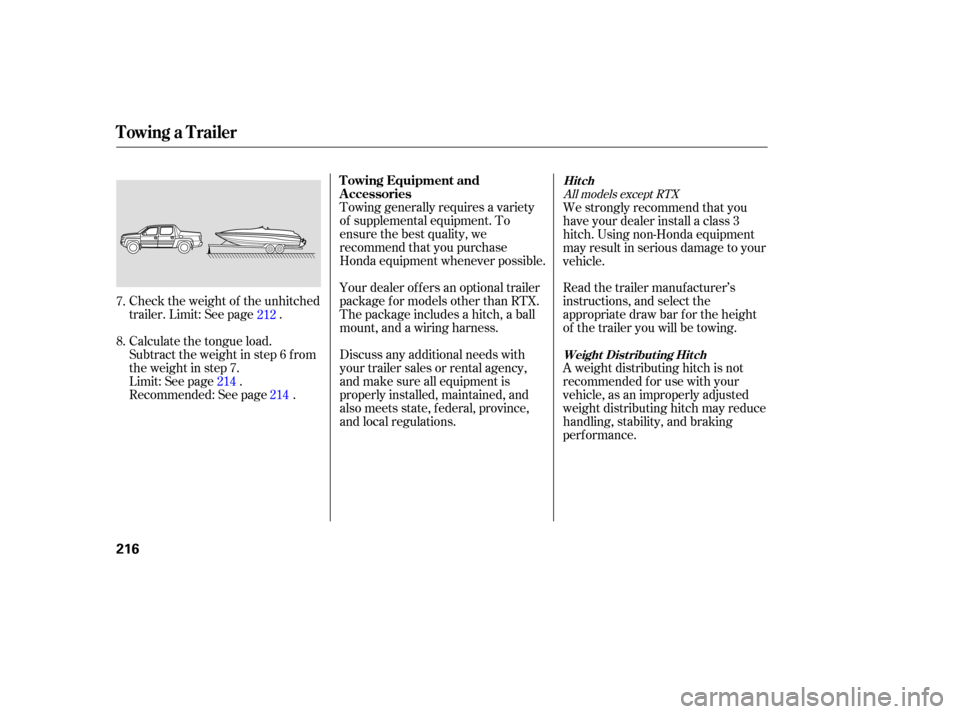Page 220 of 331

Check the weight of the unhitched
trailer. Limit: See page . Towing
generally requires a variety
of supplemen tal equipmen t. To
ensure the best quality, we
recommend that you purch ase
Honda equipment whenever possible.
Calculate the tongue load.
Subtract the weight in step 6 from
the weight in step 7.
Limit: See page .
Recommended: See page .Your dealer of f ers an optional trailer
package f or models other than RTX.
The package includes a hitch, a ball
mount, and a wiring harness.
Discuss any additional needs with
your trailer sales or rental agency,
and make sure all equipment is
properly installed, maintained, and
also meets state, f ederal, province,
and local regulations.
A weight distributing hitch is not
recommended f or use with your
vehicle, as an improperly adjusted
weight distributing hitch may reduce
handling, stability, and braking
perf ormance. Read the trailer manufacturer’s
instructions, and select the
appropriate draw bar f or the height
of the trailer you will be towing. We strongly recommend that you
have your dealer install a class 3
hitch. Using non-Honda equipment
may result in serious damage to your
vehicle.
7.
8. 212
214 214
All models except RTX
T owing Equipment and
A ccessoriesHitch
Weight Distributing Hitch
Towing a Trailer
216
Page 228 of 331

The added weight, length, and
height of a trailer will af f ect your
vehicle’s handling and perf ormance,
so driving with a trailer requires
some special driving skills and
techniques.
Your vehicle tires and spare are in
good condition and properly
inf lated.
The trailer tires and spare are in
good condition and inf lated as
recommended by the trailer
maker.
The vehicle has been properly
serviced, and the tires, brakes,
suspension, cooling system, and
lights are in good operating
condition.
The trailer has been properly
serviced and is in good condition.
All weights and loads are within
limits.
Thehitch,safetychains,andany
other attachments are secure.
Allitemsonandinthetrailerare
properly secured and cannot shif t
while you drive. Towing perf ormance can be
af f ected by high altitude, high
temperature, or when climbing
steep grades. Theref ore, premium
f uel (premium unleaded gasoline
with pump octane number of 91 or
higher) is recommended when
towing more than 3,500 lbs (1,590
kg).
Foryoursafetyandthesafetyof
others,taketimetopracticedriving
maneuvers bef ore heading f or the
open road, and f ollow the guidelines
below.
Avoid towing a trailer during your
vehicle’s f irst 600 miles (1,000 km).
When preparing to tow, and bef ore
driving away, be sure to check the
f ollowing:
Driving Saf ely With a T railer
Pre-T ow Checklist
Towing a Trailer
Break-In Period
224
Page 306 of 331

�Î�Î
�Î
�Î
�Î
�µ�µ �Î
�Î
�Î
�Î
�Î
Specif ications
302
Capacities
Dimensions
Weights
Air Conditioning 1.64 US gal (6.2
)
2.14 US gal (8.1)
4.5 US qt (4.3
)
4.2 US qt (4.0
)
5.3 US qt (5.0
)
3.3 US qt (3.1)
8.5 US qt (8.0)
206.7 in (5,250 mm)
78.0 in (1,980 mm)
70.3 in (1,785 mm)
2.79 US qt (2.64
)
3.01 US qt (2.85)
0.45 US qt (0.43
)
0.48 US qt (0.45)
0.16 US gal (0.6
) 4.8 US qt (4.5
)
Excluding the oil remaining in the engine Including the coolant in the reserve tank and that remaining in the
engine
Reserve tank capacity:
Fuel tank
Engine
coolant
Engine oil
Automatic
transmission
fluid
Rear
differential
fluid
Transfer
assembly
fluid
Windshield
washer
reservoir
Length
Width
Height
Wheelbase
Track
122.0 in (3,100 mm)
67.1 in (1,705 mm)
66.9 in (1,700 mm) 22.01 US gal (83.3
)
See the tire information label
attached to the driver’s doorjamb.
Gross vehicle weight rating
Gross combined weight
rating (GCWR)
Maximum load limit
(Payload)
The GCWR must be reduced 2 percent for every 1,000 feet (305
meters) of elevation.
Refrigerant type
Charge quantity
Lubricant type HFC-134a (R-134a)
21.2 22.9 oz (600 650 g) ND-OIL8 Approx.
Front
Rear
1:
2:Change
Total
Change
Including
filter
Without
filter
Total
Change
Total
Change
Total
Change
Total
10,088 lbs (4,575 kg)
1:
2:
3: On vehicles without moonroof or navigation system 1,530 lbs (690 kg)
1,480 lbs (670 kg)
On vehicles with moonroof and navigation system
1 1
2
2
3
Page 310 of 331

�µ
�µ
�µ
�µ
�µ
�µ �µ
�µ
�µ
�µ
�µ
�µ �µ
The tires that came on your vehicle
have a number of markings. Those
you should be aware of are described
below.
Rim diameter in inches.
Load index (a numerical code
associated with the maximum
load the tire can carry).
Speed symbol (an
alphabetical code indicating
the maximum speed rating).
The tire identif ication number (TIN)
is a group of numbers and letters
that look like the f ollowing example
TIN. TIN is located on the sidewall
of the tire.
Tire construction code (R
indicates radial). Aspect ratio (the tire’s section
height as a percentage of its
width). Tire width in millimeters. Vehicletype(Pindicates
passenger vehicle). Tire type code.
Date of manuf acture.
The maximum air
pressurethetirecan
hold.
Max Press
Max Load The maximum load the
tire can carry at
maximum air pressure.
Whenever tires are replaced, they
should be replaced with tires of the
same size. Below is an example of
tire size with an explanation of what
each component means.
Manuf acturer’s
identification mark.
This indicates that the tire
meets all requirements of
the U.S. Department of
Transportation.
R DOT
B97RFW6X
2202
65 245 P 17
105
S
Tire Labeling
Tire Size
T ire Ident if icat ion NumberMaximum T ire Pressure
Maximum T ire L oad
306
P245/65R17 105S DOT B97R FW6X 2202